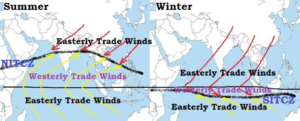Monsoons in India
Monsoons in India
Q) Explain the mechanism of monsoons in India.
STRUCTURE
Introduction – A short introduction ( 15 words)
Body – Explain mechanism of monsoons in India (220 words)
Conclusion – Mention a short conclusion (15 words)
ANSWER
The term monsoon has been derived from the Arabic word mausin or from the Malayan word monsin meaning ‘season’. Monsoons are seasonal winds (Rhythmic wind movements)(Periodic Winds) which reverse their direction with the change of season.
The origin and the mechanism of monsoons are not fully understood yet. No single theory is found to explain the phenomenon in a satisfactory manner. The two broad categories of theories explaining the monsoon phenomenon are:
Classical Theory
Modern Theory
CLASSICAL THEORY
- The earliest scientific explanation of monsoons was provided by Sir Edmund Halley in 1686. He observed that monsoon winds are an outcome of thermal contrast between the continental landmass and oceans which, in turn, was due to differential heating of the two. Halley has identified summer and winter monsoons as two distinct processes.
- Summer Monsoon: During summer, the sun shifts northwards of the Equator and shines vertically over the Tropic of Cancer. This creates a low-pressure region over South and Central Asia due to intense heating of the landmass. This low-pressure region attracts cooler winds from the surrounding ocean. The moisture-laden winds blowing from the Indian Ocean cause heavy rainfall over South Asia.
- Winter Monsoon: During winter, the sun shifts southwards and the temperature in the northern hemisphere begins to fall. This creates a high-pressure zone over South and Central Asia, which is cooler than the surrounding Arabian Sea and Bay of Bengal. Thus, a reversal in the direction of winds occurs during winters with monsoon winds blowing away from the land towards the sea.
- Halley's explanation of monsoons is identical to the system of diurnal land and sea breezes which has been extrapolated over larger bodies of continents and oceans for longer durations.
MODERN THEORIES
Halley's theory of monsoons which is based on differential heating of land and ocean could not fully explain the intricacies of the monsoons. Aside from the differential heating, other aspects such as the shape of the landmass, orography, and the circulation of air in the upper atmosphere also play a role in the development of monsoon. Several studies which were conducted during the twentieth century have thrown new light on our understanding of the monsoons.
AIR MASS THEORY
Inter Tropical Convergence Zone (ITCZ) is a region where the trade winds coming from northern and southern hemispheres meet. ITCZ, which is usually situated at the equator, is a region of ascending air with thick cloud formation and heavy rainfall. The location of ITCZ keeps changing with seasons. As the sun shines vertically above the Tropic of Cancer during summers in the northern hemisphere, ITCZ shifts northwards. The trade winds coming from the southern hemisphere after crossing the equator blow from the southwest direction due to the presence of Coriolis Force. These winds become the southwest monsoon winds. The region where the southwest trade winds meet the northeast trade winds is known as the Monsoon Front. In the month of July, the ITCZ is situated between 20 and 25 degrees north latitudes. The ITCZ in this region is termed as the Monsoon trough and the southwest monsoons from the Arabian Sea and Bay of Bengal blow towards it.
JET STREAM THEORY
- A jet stream is a band of fast-moving air, usually found in the upper troposphere at a height of around 12 km, blowing from west to east in general. The wind speeds are in the range of 150 to 300 kmph with extreme values touching 400kmph.
- The periodic movement of the subtropical westerly jet stream over the Indian subcontinent is found to be responsible for the onset and subsequent withdrawal of the southwest monsoons. The subtropical jet stream is split by the Himalayas into two branches and the southern branch of the jet stream lies to the south of the Himalayas, over the northern plains. The northward shift of this branch of the jet stream, beyond the Himalayas, is considered to be the first indication of the onset of monsoons as it helps the northward movement of the ITCZ.
- Tibetan plateau also has an important role in the strengthening of monsoons. Since the plateau is situated at a height of around 4000m above the mean sea level, it experiences intense heating during the summer season. This creates a band of rising air over the region which begins to move outwards and gradually sinks over the Indian Ocean. Due to the presence of Coriolis Force, it is deflected towards its right and after sinking, it finally approaches the west coast of India adding to the southwest monsoon winds.
- Another jet stream appears over the Indian Ocean region during the summers at a height of around 13 km. It is known as the Tropical easterly jet and it aids in the occurrence of monsoons rainfall over the Indian landmass. The duration and intensity of the heating of Tibetan plateau have a direct bearing on the strengthening of the easterly jet. A strong easterly jet implies heavy rainfall in India. The westerly jet and the easterly jet, along with the monsoon trough are a part of the Hadley circulation.

